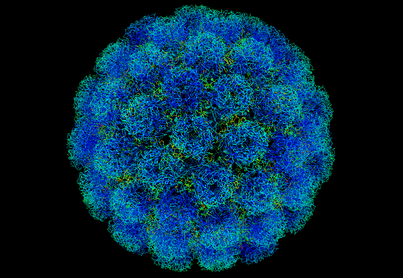Viruses aren’t always villains!
- Bate-papo com Netuno
- 4 de jul. de 2019
- 4 min de leitura
Atualizado: 24 de jul. de 2020
English edit by Carla Elliff
Who here has never been sick because of a virus? Generally, viruses are always associated with bad situations in our lives, feeling ill and diseases (dangerous or not). But in the oceans, viruses have a very important role.
First you must know that a virus can infect practically every life form, including bacteria, archaea and microeukaryotes, which are the basis of the food webs in the oceans. And did you know that a certain group of marine bacteria (SAR11) is considered the most abundant group of organisms on our planet? SAR11 can inhabit places where most organisms could not survive. These marine bacteria have such a fantastic distribution that they used to be thought of as invulnerable. However, a few years ago, a group of marine viruses (pelagiphages) were discovered infecting and killing millions of these SAR11 bacteria per second. You’ll soon find out why this is so important.

Studies from the 1990s and 2000s showed that once a viral infection killed its host, cell matter (meaning nutrients and carbon) was released back into the microbial loop of the oceans. But hang on, what is a microbial loop?
Before we talk about the microbial loop, we need to talk about the food web, which represents the feeding relationships among organisms. It is through the food web that the energy from the sun can reach all living things, including us, mere human beings. Energy from the sun is absorbed and converted into carbon in the ocean by primary producers (phytoplankton), which are eaten by zooplankton, which are then eaten by fish, which are then eaten by bigger fish, birds and/or whales. But this classic description of a food web (phytoplankton-zooplankton-fish) is just one component in a much more complex cycle. And although the microbial loop is less known, it is not less important.

Back to what in fact is this microbial loop. Put simply, it is the process through which the microbial community (especially bacteria) degrades organic matter. This organic matter can be derived from the excretes of organisms, from zooplankton’s sloppy feeding (when zoo doesn’t consume their food whole, releasing unconsumed bits to the waters around them), and from the breaking down and dissolution of matter from plants and others. This organic matter is not initially available for direct absorption by most organisms. The paramount role of bacteria is to reintroduce this carbon into the cycle, meaning, back into the food web. And this represents a very important additional source of energy to the system.
The term microbial loop was invented by a very famous Pakistani scientist called Farooq Azam and his collaborators. I had the opportunity to watch an amazing talk by Dr. Azam at an ASLO meeting (ASLO stands for Association for the Sciences of Limnology and Oceanography) in 2013, held in New Orleans. He had only one slide and still managed to time out, but no one had the guts to interrupt because it was like listening to a fairytale, where microbes were the main character and the story was being told by the writer himself. Unmissable! If you’d like to know more about the work done by this researcher, access his webpage.
Back to the main character of this story, viruses! As I said at the beginning of the post, viruses have an important role in the microbial loop. Laboratory experiments have indicated that this release of cell matter by viruses can stimulate the growth of the microbial community. There is also evidence that viruses are responsible for the turnover of 20-50% of bacterial communities per day. If these estimates are accurate, then viruses can increase the flow in organic matter (carbon) to the bottom of the oceans, when compared with ecosystems with no viruses. And this is important because the climate of our planet is largely regulated by this flow of carbon to the bottom of the oceans, which is mediated by living organisms (the famous biological pump, as described in the image above). This means that the fact that this year was scorching hot in your hometown is in some way associated with the balance of carbon flow in different parts of the oceans worldwide.
We still know little about marine viruses. The viruses in the picture here were isolated during the TARA Oceans expedition. They are so small you would have to put 250 of them side by side to reach the width of a strand of hair. More recent studies indicate that these pelagiphages are nearly as abundant as SAR11 bacteria, the “invulnerables”, described above. Therefore, knowing more about marine viruses will help us understand better about how carbon is stocked and released in the ocean. While my cold last week had nothing to do with these fantastic organisms, they have everything to do with the balance of our planet.
Viruses come in all shapes and sizes!
If you liked today’s post, leave a comment! This way we can seek guests to further explore themes that you guys think are interesting.
See you next time!
References and interesting news:
Shelford EJ, Middelboe MM, Møller EF, Suttle CAS. (2012). Virus-driven nitrogen cycling enhances phytoplankton growth. Aquat Microbial Ecol, 66: 41–46.
Weitz J. S. et al., 2014. A multitrophic model to quantify the effects of marine viruses on microbial food webs and ecosystem processes. The ISME Journal, 1–13.
Buchan, A.; LeCleir, G. R.; Gulvik, C. A.; Gonzalez, J. M. (2014). Master recyclers: features and functions of bacteria associated with phytoplankton blooms. Nature Reviews Microbiology, 12, 686 - 698.









Comentarios